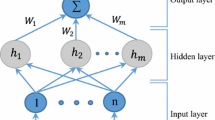Abstract
For the social robot with serial elastic actuator, the joint dynamics model has the problems of strong coupling and high nonlinear, and the traditional PD control algorithm cannot achieve accurate trajectory tracking effect on the joint position of social robot using series elastic actuator. Therefore, an optimized Radial basis function (RBF) neural network adaptive control algorithm was proposed. The method based on RBF neural network approximates the social robot joint model parameters, an adaptive law was designed to estimate the weights of the neural network and the joint model online. The dynamic plane method is combined to improve the robustness of the control algorithm. The simulation results show that the trajectory tracking error peak of PD control algorithm is 0.2 rad. Compared with PD control algorithm, the trajectory tracking error peak of RBF neural network adaptive control algorithm based on dynamic surface optimization is reduced to ± 0.05 rad, which realizes accurate approximation of the parameters of social robot joint model, and accurate dynamics model approximation provides a theoretical basis for further research on human–robot interaction (HRI) of social robots.

















Similar content being viewed by others
References
Wang Y, Chen Y, Chen K, Wu Y, Huang Y (2017) A flat torsional spring with corrugated flexible units for series elastic actuators. In: 2nd International conference on advanced robotics and mechatronics (ICARM). IEEE, pp 138–143.
Li X, Pan Y, Chen G, Yu H (2016) Adaptive human–robot interaction control for robots driven by series elastic actuators. IEEE Trans Rob 33(1):169–182
Calanca A, Muradore R, Fiorini P (2017) Impedance control of series elastic actuators: passivity and acceleration-based control. Mechatronics 47:37–48
Zhu Q, Mao Y, Xiong R, Wu J (2016) Adaptive torque and position control for a legged robot based on a series elastic actuator. Int J Adv Rob Syst 13(1):26
Calzado J, Lindsay A, Chen C, Samuels G, Olszewska JI (2018). SAMI: interactive, multi-sense robot architecture. In: IEEE 22nd International conference on intelligent engineering systems (INES). IEEE, pp 000317–000322
Brooks R (1986) A robust layered control system for a mobile robot. IEEE J Robot Autom 2(1):14–23
Murphy RR (2019) Introduction to AI robotics. MIT Press, Cambridge
Connell JH (1992) SSS: a hybrid architecture applied to robot navigation. In: ICRA, vol 3, pp 2719–2724
Fikes RE, Nilsson NJ (1971) STRIPS: A new approach to the application of theorem proving to problem solving. ArtifIntell 2(3–4):189–208
Gat E, Bonnasso RP, Murphy R (1998) On three-layer architectures. Artificial intelligence and mobile robots 195:210
Mattar E (2013) A survey of bio-inspired robotics hands implementation: new directions in dexterous manipulation. Robotics and Autonomous Systems 61(5):517–544
Liu X, Yang C, Chen Z, Wang M, Su CY (2018) Neuro-adaptive observer based control of flexible joint robot. Neurocomputing 275:73–82
Kong K, Bae J, Tomizuka M (2009) Control of rotary series elastic actuator for ideal force-mode actuation in human–robot interaction applications. IEEE/ASME Trans Mechatron 14(1):105–118
Kong K, Bae J, Tomizuka M (2011) A compact rotary series elastic actuator for human assistive systems. IEEE/ASME Trans Mechatron 17(2):288–297
Yoo S, Chung WK (2015) SEA force/torque servo control with model-based robust motion control and link-side motion feedback. In: IEEE international conference on robotics and automation (ICRA). IEEE, pp 1042–1048
Schindlbeck C, Haddadin S (2015) Unified passivity-based cartesian force/impedance control for rigid and flexible joint robots via task-energy tanks. In: 2015 IEEE international conference on robotics and automation (ICRA). IEEE, pp 440–447
Soltanpour MR, Moattari M (2019) Voltage based sliding mode control of flexible joint robot manipulators in presence of uncertainties. Robot AutonSyst 118:204–219
Cambera JC, Feliu-Batlle V (2017) Input-state feedback linearization control of a single-link flexible robot arm moving under gravity and joint friction. Robot AutonSyst 88:24–36
He W, Amoateng DO, Yang C, Gong D (2016) Adaptive neural network control of a robotic manipulator with unknown backlash-like hysteresis. IET Control Theory Appl 11(4):567–575
He W, David AO, Yin Z, Sun C (2015) Neural network control of a robotic manipulator with input deadzone and output constraint. IEEE Trans Syst Man CybernSyst 46(6):759–770
Sun L, Li M, Wang M, Yin W, Sun N, Liu J (2020) Continuous finite-time output torque control approach for series elastic actuator. MechSyst Signal Process 139:105853
Wei J, Cao D, Liu L, Huang W (2017) Global mode method for dynamic modeling of a flexible-link flexible-joint manipulator with tip mass. Appl Math Model 48:787–805
Olszewska JI, Houghtaling M, Goncalves PJ, Fabiano N, Haidegger T, Carbonera JL et al (2020) Robotic standard development life cycle in action. J Intell Rob Syst 98(1):119–131
Acknowledgements
We thank all the participants, as well as the graduate research team led by Professor Zhou Qinyuan from Central South University of Forestry and Technology, for facilitating the discussion and providing valuable feedback. In particular, Dr. Zhou played an important role in the careful guidance in the writing process of this article. Finally, We are very grateful to Chenyang Shao, Yanzhao, Rirong Lu, Xianzhe Hu, members of the Robotics Research Group in the School of Mechatronics Engineering of Central South University of Forestry and Technology for their expertise and efforts in programming robots.
Author information
Authors and Affiliations
Corresponding author
Ethics declarations
Conflict of interest
The authors declare that they have no conflict of interest.
Additional information
Publisher's Note
Springer Nature remains neutral with regard to jurisdictional claims in published maps and institutional affiliations.
Rights and permissions
About this article
Cite this article
Shao, N., Zhou, Q., Shao, C. et al. Adaptive Control of Robot Series Elastic Drive Joint Based on Optimized Radial Basis Function Neural Network. Int J of Soc Robotics 13, 1823–1832 (2021). https://doi.org/10.1007/s12369-021-00762-0
Accepted:
Published:
Issue Date:
DOI: https://doi.org/10.1007/s12369-021-00762-0




